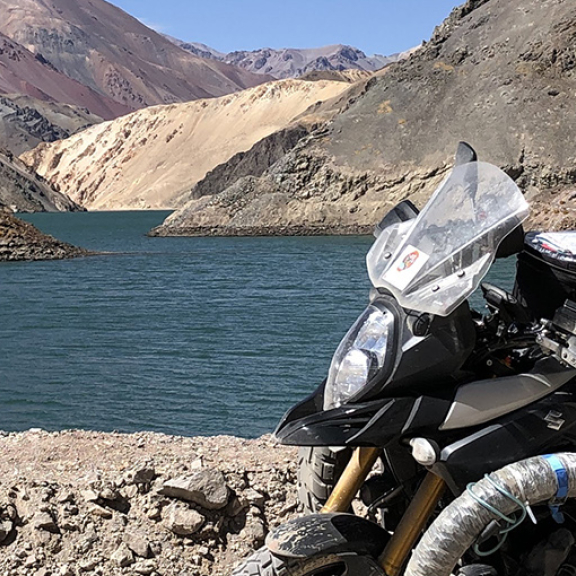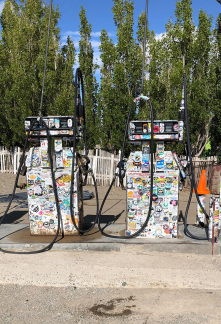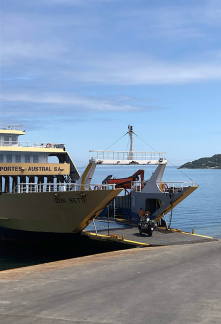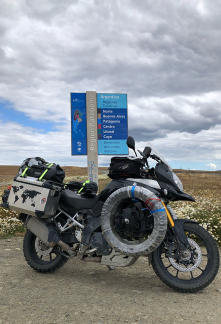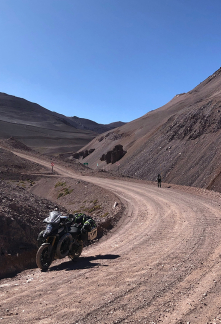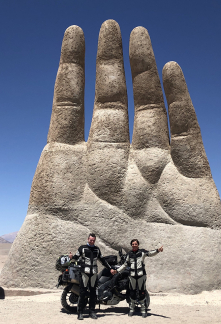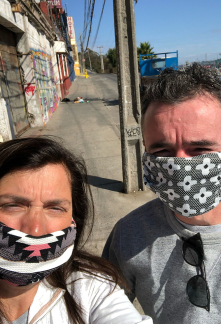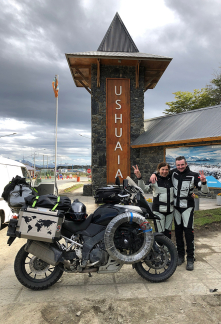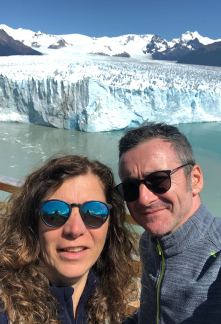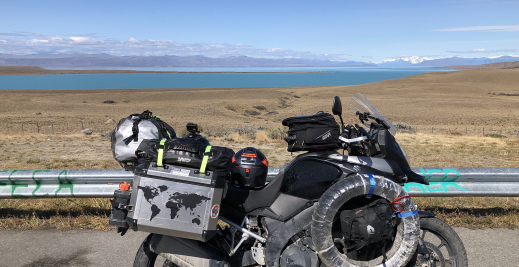In the summer of 2019, we decided to tackle what we saw as a major undertaking, though the journey turned out to be easier than expected. After arranging unpaid leave from work (having requested it well in advance), we encountered our first real organisational challenge: shipping the motorcycle (just one, as at that time Sonia had a Ducati Monster, definitely not suitable for this type of trip). After seeking advice from travellers with more experience than us, and requesting a number of quotes, we chose to entrust the motorcycle and related documents to a Polish company called Motobirds. The person we dealt with was Aleksandra, who also owns the company.
What can we say about them? They did an excellent job, were always available with any information we needed, kept us up-to-date on the status of the motorcycle with photos and videos and, last but not least, provided a great service at the San Antonio customs in Chile, where local consultant Rafael was extremely kind and helpful.
The day of our departure finally came: on 23 January 2020, we took a one-way flight from Milan-Santiago de Chile, with a stopover in Madrid! Once in Santiago, we took public transport to get to Vinã del Mar, where Evangelina was waiting for us. A motorcyclist herself, she assists people arriving from far away, like us, to find their feet on South American soil.
The following day we went to customs for our appointment with Rafael. It took just a few hours to get through the paperwork, then our great southern adventure officially began! We remained in Chile: Curicó, Talca, Los Ángeles (not the one in California!), Temuco, Osorno. It was in the last of these that, as we were searching for somewhere to spend the night, a car pulled up beside us at the traffic lights. Inside was an elderly gentleman with two puppies, who asked us what we were looking for. When we replied “a place to sleep”, he invited us to spend the night at his house without a second’s hesitation. We accepted his offer, and even now, three years later, he writes to us to ask how we're doing and when we’re coming back to visit him. Thanks for everything, Raul!
We set off again two days later in the direction of Puerto Montt, where the famous Route 7 begins. Better known as Carretera Austral, it was built on the orders of General Augusto Pinochet during the military dictatorship.
Practically the entire road is ripio (the local term for unpaved road surfaces covered in soil and stones, or sometimes large quantities of gravel).
The views are stunning, and sure to take your breath away. You don’t meet very many vehicles, making for a more relaxing ride. Although it was raining for all — or almost all — the time we spent travelling it, it is one of our stand-out memories of the entire trip.
We stopped for the night at Puerto Río Tranquilo , before paying a visit to the jaw-dropping Catedral de Marmol the next day. This stunning “Marble Cathedral” has been carved into unique, cave-like forms by the fierce waves of the lake lashing the high rocky shore. Slowly, over thousands of years, the process of erosion has produced pale stone columns, arches which reflect the turquoise and emerald gleam of the water, and mushroom-shaped rocks covered in vegetation. When the waters of the lake are low, it is even possible to go inside.
Route 7 ends at Villa O'Higgins; however, once we made it to Aldana, we decided to turn off for Puerto Guadal, skirting General Carrera Lake to reach our first border control of the trip.
We entered Argentina full of excitement, and just a few minutes later found ourselves skirting Lake Buenos Aires. That’s right: it’s the same lake, with a different name on each side of the border. Continuing south, we came to Bajo Caracoles. The petrol station in this little village is an essential stopping point, given that the nearest town is too far away to reach without refuelling. Many of you will have seen a photo or two of this site, where all passers-by leave a sticker behind.
In Gobernador Gregores, we were faced with Los Malditos 73: a difficult stretch of road, due to the conditions of the road surface as well as the fact that, with both of us on board, we were rather overloaded. Next came Tres Lagos and, finally, El Calafate, an essential stop for a visit to the majestic Perito Moreno Glacier.
Continuing on, we returned to Chile, where our destination was Puerto Natales, the base for visiting another unmissable attraction: Torres del Paine, with its jaw-dropping beauty.
From here we re-entered Argentina, then Chile, then Argentina again, in order to reach the southernmost point of our trip: Ushuaia!
Here, you truly are at THE END OF THE WORLD!!!!!!!
The temperature was around 10 degrees, not cold by any means, and we stayed for 4 or 5 days, just long enough to take a trip to the penguin colony and see Bahia Lapataia, where Route 3 ends.
Then, it was time to head back up north, and we decided to take the east coast part of the way, along the Atlantic ocean. This route turned out to be extremely boring, with level ground as far as the eye could see and strong winds, so we decided to turn west and head for San Carlos de Bariloche, a quaint and highly touristy city. The most interesting part was to come over the following days, when we came to Villa la Angostura and San Martín de Los Andes, surrounded by stunning mountains and infinite lakes of a breath-taking blue.
The next stretch brought us to Mendoza, another city well worth a visit. In the meantime, temperatures had climbed notably to over 30 degrees. To get from Mendoza to Santiago de Chile, we opted for the Los Libertadores Pass where, once we’d reached the peak, we chose to take the old road leading to the statue of Christ instead of going through the tunnel. To descend on the Chilean side, you can take the equally famous Los Caracoles: many of you will recognise this road with its infinite series of curves, each identical to the next.
We decided not to stay in the chaos of Santiago, but stopped in La Serena over the next few days. While there, we couldn’t pass up the opportunity to try out the legendary Agua Negra Pass: around 60 km of dirt road, with a multitude of colours and a spectacular lagoon at an altitude of over 3,000 metres (the pass itself is at 4,783 metres). Back in the city, we found a replacement rear tyre for the motorcycle and, carrying on, made it to Antofagasta and then San Pedro de Atacama.
Here it was extremely hot, over 37 degrees with the sun beating down. The area is worth stopping in for a few days, however, not so much for the town itself — touristy and deliberately preserved as it was 50 years ago — but for the unmissable Valley of the Moon. This immense desert valley, with its rock formations, sand dunes and arid canyons, is one of the most unforgettable places in the Atacama desert.
The next stretch brought us to Iquique and then the last Chilean city before the border, Arica, before entering Peruvian territory, at Tacna to be precise. Absolutely everything changed in the space of just a few kilometres, from the food to the clothing styles and even the cost of living, which was considerably lower in Peru.
We hardly had the time to get used to the different facial features before setting off for Arequipa, also known as the White City, which is truly unmissable and without a doubt the most beautiful city we saw on this journey. The most intense excursion you can take is to the Colca Canyon, where you can see birds with a truly extraordinary wingspan.
Our next, highly anticipated destination was Lake Titicaca. To get there, we passed through Juliaca, a poor city, and arrived in Puno, where we treated ourselves to a hotel a cut above those we were used to, thanks to the significantly lower prices. This was to be our starting point for a visit to the floating Uros Islands and to Taquile Island.
Our next stop, the northernmost one on the trip, was to be Cusco, whose beauty is comparable to Arequipa despite the considerable differences between the two cities. Cusco is by far the more touristy city, serving as a base to reach Machu Picchu. The Mountain of Seven Colours needs no introduction: transport is available to bring visitors to the parking area, from which it takes an hour and a half on foot to reach the 5,050 m peak, from where the majesty of the site can be admired. For those who don’t feel up to the walk, it is possible to pay for a service to get there on horseback.
On 13 March 2020, we needed to return to Puno to cross the border into Bolivia. Unfortunately, this was where our real problems began. Covid 19 had made its dramatic appearance, Peru had closed its borders for both entrances and exits for 15 days, and we found ourselves stuck! The following morning, we heard that the authorities had announced a 24-hour grace period to leave the country, but where were we to go? We decided to set off under a deluge and try our luck at returning to Chile (with absolutely no guarantees). Luckily, they let us in, and we made it to San Antonio in just a few days, where we sought a solution for shipping the motorcycle home.
Those days of travelling were brutal: with everything closed, we found shelter where we could at night and ate lunch at supermarkets. We spent a week shut up in a hotel where we were the only guests, eating takeaway pizza every day, constantly on the phone trying to organise a way back for the motorcycle and for ourselves… To this day, three and a half years later, we are still waiting on an answer from the Ministry of Foreign Affairs! Finally, we were able to bring the motorcycle to customs and send it back using the same courier as we had on the way there. Our own route was: Santiago-Madrid, Madrid-Paris, Paris-Rome, and a train to Salsomaggiore Terme. As soon as we’d boarded the first of our flights, we made a promise that we’d be back to finish the part that was cut short, and — why not? — to go even further.
It was an undeniably important journey for us; though partly ruined, it taught us a lot and toughened us up, to be ready for more new adventures.
Till next time…! Sonia and Matteo, On the Road
Sonia and Matteo
We're two motorcycle travellers from the province of Parma in Italy, though with two very different backgrounds.
Sonia and Matteo
We're two motorcycle travellers from the province of Parma in Italy, though with two very different backgrounds.
Sonia, originally from Vicenza, has a classic family of three children, and discovered her passion for motorcycles after turning 40.
Matteo, with no family ties, is passionate about motorcycles and travelling… often on his own!
We met in 2017, and from there came up with the idea of combining our passions… and travelling by motorcycle!
In summer 2018 our first destination far from home: North Cape. In 2020 came our second major journey, in South America. Next, in 2022, we treated ourselves to an exploration of the East to mark our honeymoon, across Turkey, Iraq, Iran, Armenia, Georgia and back again.
In 2024, we will set out for Alaska and make our way to Ushuaia in Argentina: an adventure that will last 8 months and 50,000 km!

